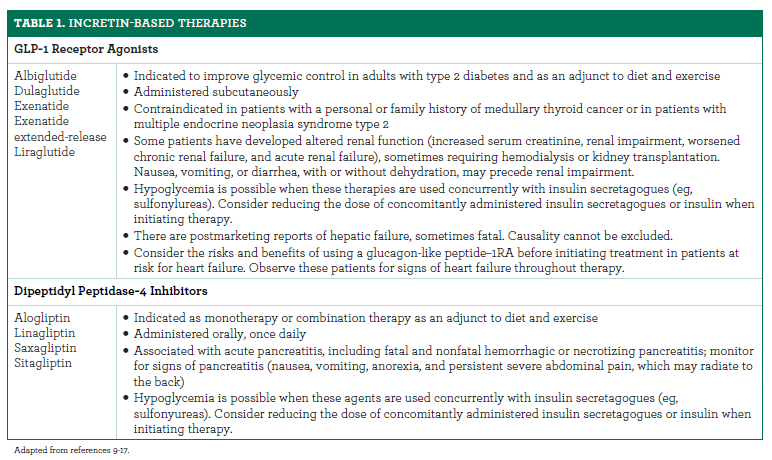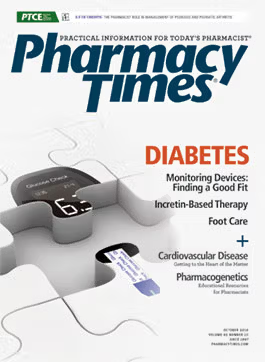Publication
Article
Pharmacy Times
Incretin-Based Therapy: Alternatives to Metformin
Author(s):
Practice guidelines include incretin-based therapies as alternative monotherapy agents when metformin is contraindicated or as a component of combination therapy.
Metformin is the drug of choice for treating type 2 diabetes (T2D), when lifestyle changes alone fail to control blood glucose, and is especially useful for overweight patients.1-3 Metformin may prevent the cardiovascular complications of diabetes and has emerging use in treating cancers (diabetes-related and others).4 In T2D, the treatment goal is tight glycemic control, but as beta cell function declines progressively, many patients need treatment intensification with a second glucose-lowering agent.5
Patients with T2D may have abnormalities that affect the release, or action, of incretin hormones, specifically glucagon-like peptide-1 (GLP-1) and glucose-dependent insulinotropic polypeptide (GIP). These hormones control almost all postprandial insulin release. Since 2005, incretin- based therapies have been available. Practice guidelines include incretin-based therapies as alternative monotherapy agents when metformin is contraindicated or as a component of combination therapy.1-3
GLP IN THE GUT
GLP originates in the small intestine and colon and is released after eating. GLP-1 stimulates insulin secretion, but glucose must be present in the bloodstream for it to activate. GLP-1 delays stomach emptying, slows carbohydrate absorption, prevents the subsequent rise in the blood glucose level after meals, and suppresses appetite. Animal studies and in vitro work indicate GLP-1 may promote pancreatic beta cell regeneration and slow apoptosis (programmed cell death), lengthening existing beta cells’ lives.6,7
GIP is released when glucose comes into contact with cells in the upper small intestine. GIP stimulates insulin secretion from pancreatic beta cells to promote beta cell proliferation and improve beta cell survival.6,8
The dipeptidyl peptidase-4 (DPP4) enzyme regulates GLP-1 and GIP, leading to incretin breakdown.6,8 Table 19-17 lists drugs that affect GLP-1 and GIP, their indications, and key treatment points.

Incretin-based therapies are associated with the following:
- Glycated hemoglobin (A1C) reductions of approximately 0.5 to 1 percentage points for DPP4 agents and 0.8 to 2 points for GLP-1 agents
- Improvements in fasting blood glucose and postprandial blood glucose
- Low risk of hypoglycemia (except when combined with sulfonylureas)
- Favorable adverse-effect profile (no associated weight gain when administered as monotherapy; GLP-1 receptor agonists have been associated with weight loss)
- Favorable effects on cardiovascular factors and biomarkers (ie, although incretin-based therapies should not be used as primary therapy for cardiovascular disease, lipid profile improvements and blood pressure reductions have been observed and may offer additional benefits in at-risk patients with T2D).7,18
GUIDELINE RECOMMENDATIONS
Clinicians primarily use 2 guidelines: the American Diabetes Association/European Association for the Study of Diabetes (ADA/ EASD) and the American Association of Clinical Endocrinologists (AACE). The ADA/EASD position statement for medical management of T2D indicates that incretin-based therapies are appropriate as the following1-2:
- Initial monotherapy if metformin cannot be used
- Part of a dual-combination therapy regimen with metformin when monotherapy is insufficient
- Part of a triple-combination therapy regimen with metformin and a sulfonylurea, metformin and a thiazolidinedione, or metformin and basal insulin
The AACE acknowledges that incretin-based therapies are appropriate as the following3:
- An option for monotherapy in patients with a baseline A1C <7.5%; the AACE recommends GLP-1 agonists as a second choice after metformin monotherapy and DPP4 inhibitors as a fourth choice (sodium-glucose cotransporter-2 inhibitors are the third choice)
- Add-on therapy in patients whose A1C remains >7.5% after 3 months on monotherapy
- Components of dual therapy with metformin (preferred) or another first-line agent for initial therapy in patients with an A1C ≥7.5% or with an A1C >9% and no symptoms
- Components of triple therapy with metformin (preferred) and a second-line agent in patients whose goal A1C remains unmet after 3 months of a dual-therapy regimen or in patients who initially present with an A1C >9% with symptoms
COMBINATION THERAPY: WHAT IS SAFE?
Each incretin-based therapy’s prescribing information outlines its safe, effective, evidence-based use as monotherapy and its role in combination therapy. Online Table 29-17 summarizes the studies conducted as part of each product’s labeling.
Table 2. Incretin-Based Pivotal Trials
Alogliptin17 Nesina
Linagliptin16 Tradgenta
Saxagliptin10 Onglyza
Sitagliptin6 Januvia
Albiglutide11 Tanzeum
Exentide10 Byetta
Exentide ER9 Bydureon
Iraglutide12 Victoza
Dulaglutide13 Trulicity
Monotherapy
Yes
Yes
Yes
Yes
Yes
Yes
Yes
Yes
Yes
Add-on combination therapy with metformin
Yes
Yes
Yes
Yes
Yes
Yes
Yes
Yes
Yes
Initial combination therapy with metformin
Yes
Yes
Yes
Add-on to a thiazolidinedione
Yes
Yes
Yes
Yes
Yes
Yes
Initial combination therapy with a thiazolidinedione
Yes
Yes
Yes
Yes
Add-on to a thiazolidinedione and metformin
Yes
Yes
Yes
Add-on to a sulfonylurea
Yes
Yes
Yes
Yes
Yes
Yes
Yes
Add-on to metformin and a sulfonylurea
Yes
Yes
Yes
Yes
Yes
Add-on to glimepiride (with or without metformin)
Yes
Add-on to insulin (with or without metformin)
Yes
Yes
Yes
Yes
Yes
Yes
Yes
Adapted from references 9-17.
CONCLUSION
In the future, pharmacists can expect to see these drug classes used for other indications. Researchers suspect a link between neurodegenerative diseases and T2D and are investigating incretin’s effects in several diseases. GLP-1 receptor agonists have shown promise in neurodegenerative diseases in preclinical studies and are being studied in humans with Alzheimer disease and Parkinson disease. DPP4 inhibitors are also being studied.19
Ms. Wick is a visiting professor at the University of Connecticut School of Pharmacy.
References
- Inzucchi SE, Bergenstal RM, Buse JB, et al. Management of hyperglycemia in type II diabetes: a patient centered approach. Position paper of the American Diabetes Association and the European Association for the Study of Diabetes. Diabetes Care website. care.diabetesjournals.org/content/early/2012/04/17/dc12-0413.full.pdf. Published April 19, 2012. Accessed September 14, 2014.
- Inzucchi SE, Bergenstal RM, Buse JB, et al. Management of hyperglycemia in type 2 diabetes, 2015: a patient-centered approach: update to a position statement of the American Diabetes Association and the European Association for the Study of Diabetes. Diabetes Care. 2015;38(1):140-149. doi: 10.2337/dc14-2441.
- Garber AJ, Abrahamson MJ, Barzilay JI, et al; American Association of Clinical Endocrinologists (AACE); American College of Endocrinology (ACE). Consensus statement by the American Association of Clinical Endocrinologists and American College of Endocrinology on the comprehensive type 2 diabetes management algorithm—2016 executive summary. Endocr Pract. 2016;22(1):84-113. doi: 10.4158/EP151126.CS.
- Zhang HH, Guo XL. Combinational strategies of metformin and chemotherapy in cancers. Cancer Chemother Pharmacol. 2016;78(1):13-26. doi: 10.1007/s00280-016-3037-3.
- Mamza J, Mehta R, Donnelly R, Idris I. Important differences in the durability of glycaemic response among second-line treatment options when added to metformin in type 2 diabetes: a retrospective cohort study. Ann Med. 2016;48(4):224-234. doi: 10.3109/07853890.2016.1157263.
- Holst JJ, Gromada J. Role of incretin hormones in the regulation of insulin secretion in diabetic and nondiabetic humans. Am J Physiol Endocrinol Metab. 2004;287(2):E199-E206.
- Hansen KB, Knop FK, Holst JJ, Vilsbøll T. Treatment of type 2 diabetes with glucagon-like peptide-1 receptor agonists. Int J Clin Pract. 2009;63(8):1154-1160. doi: 10.1111/j.1742-1241.2009.02086.x.
- Prasadan K, Shiota C, Xiangwei X, Ricks D, Fusco J, Gittes G. A synopsis of factors regulating beta cell development and beta cell mass [Epub ahead of print]. Cell Mol Life Sci. 2016.
- Byetta [package insert]. Princeton, NJ: Bristol-Myers Squibb Company; 2015.
- Bydureon [package insert]. Princeton, NJ: Bristol-Myers Squibb Company; 2015.
- Tanzeum [package insert]. Research Triangle Park, NC: GlaxoSmithKline; 2014.
- Victoza [package insert]. Plainsboro, NJ: Novo Nordisk A/S; 2016.
- Trulicity [package insert]. Indianapolis, IN: Eli Lilly and Company; 2015.
- Januvia [package insert]. Whitehouse Station, NJ: Merck and Co, Inc; 2016.
- Onglyza [package insert]. Princeton, NJ: Bristol-Myers Squibb; 2016.
- Tradjenta [package insert]. Ridgefield, CT: Boehringer Ingelheim Pharmaceuticals, Inc; 2015.
- Nesina [package insert]. Deerfield, IL: Takeda Pharmaceuticals America, Inc; 2016.
- Cobble M. Differentiating among incretin-based therapies in the management of patients with type 2 diabetes mellitus. Diabetol Metab Syndr. 2012;4(1):8. doi: 10.1186/1758-5996-4-8.
- Li Y, Li L, Hölscher C. Incretin-based therapy for type 2 diabetes mellitus is promising for treating neurodegenerative diseases [Epub ahead of print]. Rev Neurosci. 2016. doi:10.1515/revneuro-2016-0018.







